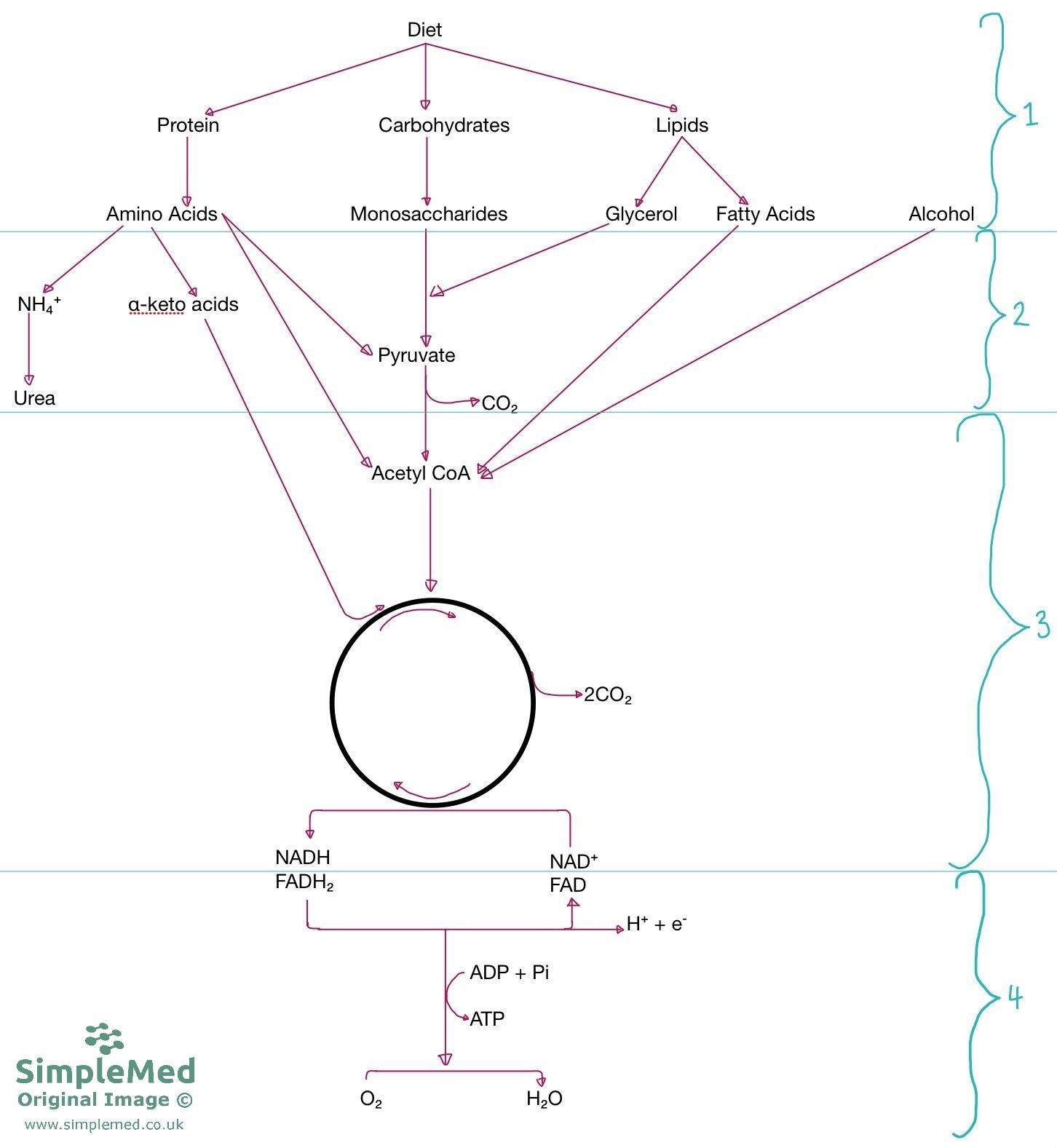Share:
Next Lesson - Glycolysis
Abstract
- The body uses all of the different parts of the diet to produce energy. They all follow a common pathway involving 4 stages.
- These stages involve the processing of food from the diet into its macromolecular components (Stage 1), the oxygen dependent conversion of glucose into ATP within cells known as glycolysis (Stage 2), the oxidative pathway that takes place within the mitochondria known as Krebs cycle (Stage 3) and the conversion of reducing energy into ATP in the process known as oxidative phosphorylation (Stage 4).
Core
This article simply summarises the common pathway that all components of the diet follow to produce energy in the body (see the diagram below). For more detail of each of the steps see the specialised articles on Metabolism Unit page.

Diagram - Overview of the Dietary Production of Energy
SimpleMed original by Maddie Swannack
- Basic digestion of the macromolecules found in the diet occurs in this stage, breaking down food into forms that can be absorbed into cells.
- This occurs extracellularly in the GI tract using enzymes (e.g. salivary amylase or pepsin).
- It is a catabolic process as it, takes complex molecules and breaks them down into simpler, building-block materials.
- There is no energy produced at this stage.
- This stage is intracellular – glycolysis (production of pyruvate) occurs in the cytosol, and the beginning of production of Acetyl CoA (the Link Reaction) occurs in the mitochondria.
- There are many pathways in stage two (e.g. pyruvate being converted strategic to Acetyl CoA or being converted to lactate and then Acetyl CoA), with not all of them occurring in all tissues.
- It is still a catabolic process, with the wider range of building block materials being simplified to less complex molecules like Acetyl CoA.
- This process is oxidative, meaning that it requires co-enzymes to be reduced (this means it needs NAD⁺ and FAD).
- It produces some energy (in the form of ATP with a net of 2; 4 molecules produced with 2 used).
- This stage is irreversible because it produces CO2, which cannot be recaptured.
Stage Three – Krebs Cycle/TCA Cycle
- This stage occurs in the mitochondria and is a single pathway called the Krebs cycle. It is the common end point for all the dietary molecules.
- It is an oxidative pathway (meaning it requires NAD⁺ and FAD).
- Some energy is produced here (in the form of GTP).
- This stage is irreversible because the acetyl group of Acetyl CoA is turned into 2CO2.
Stage Four – Oxidative Phosphorylation
- This stage also occurs in the mitochondria, across the inner membrane between the matrix and the intermembrane space.
- It involves electron transport and ATP synthesis.
- NADH and FADH2 are re-oxidised, producing H⁺ + e⁻ which are used to establish the proton motive force used to power ATP synthase.
- This step leads to large amounts of ATP are produced.
- This stage requires oxygen to be the terminal electron acceptor (reduced to H2O).
Edited by: Dr. Ben Appleby and Dr. Marcus Judge
- 6998

